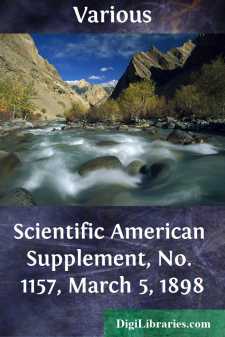Categories
- Antiques & Collectibles 13
- Architecture 36
- Art 48
- Bibles 22
- Biography & Autobiography 813
- Body, Mind & Spirit 142
- Business & Economics 28
- Children's Books 15
- Children's Fiction 12
- Computers 4
- Cooking 94
- Crafts & Hobbies 4
- Drama 346
- Education 46
- Family & Relationships 57
- Fiction 11828
- Games 19
- Gardening 17
- Health & Fitness 34
- History 1377
- House & Home 1
- Humor 147
- Juvenile Fiction 1873
- Juvenile Nonfiction 202
- Language Arts & Disciplines 88
- Law 16
- Literary Collections 686
- Literary Criticism 179
- Mathematics 13
- Medical 41
- Music 40
- Nature 179
- Non-Classifiable 1768
- Performing Arts 7
- Periodicals 1453
- Philosophy 64
- Photography 2
- Poetry 896
- Political Science 203
- Psychology 42
- Reference 154
- Religion 513
- Science 126
- Self-Help 84
- Social Science 81
- Sports & Recreation 34
- Study Aids 3
- Technology & Engineering 59
- Transportation 23
- Travel 463
- True Crime 29
Scientific American Supplement, No. 497, July 11, 1885
by: Various
Categories:
Description:
Excerpt
FOUNDATIONS IN QUICKSAND.
Foundations in quicksand often have to be built in places where least expected, and sometimes the writer has been able to conveniently span the vein with an arch and avoid trouble; but where it cannot be conveniently arched over, it will be necessary to sheath pile for a trench and lay in broad sections of concrete until the space is crossed, the sheath piling being drawn and reset in sections as fast as the trenches are leveled up. The piling is left in permanently if it is not wanted again for use.
Sometimes these bottoms are too soft to be treated in this manner; in that case boxes or caissons are formed, loaded with stone and sunk into place with pig iron until the weight they are to carry is approximated. When settled, the weights are removed and building begins.
Foundations on shifting sand are met with in banks of streams, which swell and become rapids as each winter breaks up. This kind is most troublesome and dangerous to rest upon if not properly treated.
Retaining walls are frequently built season after season, and as regularly become undermined by the scouring of the water. Regular docking with piles and timbers is resorted to, but it is so expensive for small works that it is not often tried.
Foundations are formed often with rock well planted out; and again success has attended the use of bags of sand where rough rock was not convenient or too expensive.
In such cases it is well to try a mattress foundation, which may be formed of brushwood and small saplings with butts from ½ inch to 2½ inches in diameter, compressed into bundles from 8 to 12 inches diameter, and from 12 to 16 feet long, and well tied with ropes every four feet. Other bundles, from 4 to 6 inches diameter and 16 feet long, are used as binders, and these bundles are now cross-woven and make a good network, the long parts protruding and making whip ends. One or more sets of netting are used as necessity seems to require. This kind of foundation may be filled in with a concrete of hydraulic cement and sand, and the walls built on them with usual footings, and it is very durable, suiting the purpose as well as anything we have seen or heard of.—Inland Architect.
* * * * *
This bridge, which was inaugurated in 1868, was constructed under the direction of Mr. Mantion, then engineer-in-chief of the Belt Railway. Fig. 1 shows the bridge raised.
The solution adopted in this case was the only feasible one that presented itself, in view of the slight difference between the level of the railway tracks and the maximum plane of the canal water. This circumstance did not even permit of a thought of an ordinary revolving bridge, since this, on a space of 10 inches being reserved between the level of the water and the bottom of the bridge, and on giving the latter a minimum thickness of 33 inches up to the level of the rails, would have required the introduction into the profile of the railroad of approaches of at least one-quarter inch gradient, that would have interfered with operations at the station close by....












